Abstract
Modified clay (MC) technology is the most effective method to control harmful algal blooms (HABs) and has been widely testified in many countries in recent decades. Although dissolved algal organic matter (dAOM) has been found to be abundant in HAB-affected waters, little is known about its effect on MC flocculation. Prorocentrum donghaiense was chosen as the model organism in this study. The flocculation of MC with different concentrations of dAOM was observed by particle image velocimeter, and the removal efficiency of MC to microalgae was determined using a fluorometer. The results showed that a small amount of dAOM resulted in faster flocculation, larger flocs, higher floc strength and better floc regeneration capacity, and the removal efficiency of microalgae by MC could reach about 80%. However, large amounts of dAOM produced during the occurrence of HABs could inhibit the flocculation of MC, and the removal efficiency of microalgae was only about 35%. Furthermore, with the increase of dAOM, the zeta potential of MC particles decreases from 1.56 mV to −18.9 mV, and the repulsive force between the particles also increases. The examination of 18-angle laser light scattering gel permeation chromatography and specific ultraviolet absorption (SUVA254) revealed that some hydrophobic organic macromolecules preferred to attach to MC and increase MC flocculation at a tiny amount of dAOM, while a higher concentration of dAOM would inhibits flocculation by reducing surface activity and intergranular repulsion. According to the findings of this study, the dosage of MC must be increased in order to obtain the best algal removal efficiency with MC.
1. Introduction
Harmful algal blooms (HABs) occur when colonies of algae—simple plants that live in the sea and freshwater—grow out of control and produce toxic or harmful effects on people, fish, shellfish, marine mammals and birds [1,2,3]. Modified clay (MC) technology has been testified and regarded as one of the most promising methods for HAB control in many countries, and has been widely applied along the Chinese coastal sea to control large-scale HABs [4,5]. Hydrolytic aluminum salts, such as polyaluminum chloride (PAC), have become a common material used in the preparation of MCs due to their positive surface charge and high flocculation efficiency [6,7]. The flocculation of PAC-MC particles, which precipitate out of the water body after colliding with algal bloom organisms and aggregating into large particle flocs, is the fundamental process in PAC-MC remediation of HABs [8]. Environmental variables that impact the flocculation process and PAC-MC efficiency may interfere with the effectiveness of HAB control. As a result, determining these components and their modes of action in HAB-affected water bodies is the foundation for increasing the effectiveness of PAC-MC in HAB control.
Natural organic matter (NOM) is a complex mixture of heterogeneous organic compounds because of its unique structure and function, NOM in water has a significant impact on particle flocculation [9,10]. NOM in seawater, according to worldwide studies on marine snow, is a crucial factor influencing the aggregation and sedimentation of marine particulate matter [11]. Furthermore, Jiang et al. employed humic acid as a typical form of NOM and demonstrated that at high concentrations, it decreased the settling rate of MC and disrupted the flocculation process of MC [12]. HABs generated by Prorocentrum donghaiense have grown extremely commonly in Chinese coastal waters in recent years, as they are one of the primary algal species that generate HABs [13]. When HABs occur in seawater, a considerable quantity of algal organic matter (AOM) accumulates and AOM contributes a large amount of organic matter to the NOM [14]. According to certain research, the impact of AOM on suspended colloidal particle aggregation is determined by its molecular weight, hydrophilicity, and hydrophobicity [15]. The flocculation activity of a high-molecular-weight hydrophobic component, for example, was superior to that of a low-molecular-weight hydrophilic component [16]. Furthermore, according to the study of its effect on particle coagulation performance, the concentration of AOM influences the flocculation process between colloidal particles [15]. Bernhardt et al., for example, observed that AOM acts as a coagulation aid only at low doses [17], and that effective coagulation did not occur when the metal coagulant-to-AOM ratio was low [18,19]. Nevertheless, it is unknown if and how the abundant presence of AOM in seawater impacts the MC flocculation process and the efficiency of MC for algal removal when HABs occur.
The effect of dissolved AOM (dAOM) produced by Prorocentrum donghaiense on the MC flocculation process was investigated in this study. At the same time, we observed the changes of dAOM concentration, hydrophilicity and molecular weight, and explored the mechanism of dAOM influence on algal removal efficiency of MC. The findings of this study can provide scientific enlightenment for improving HAB mitigation efficiency of MC in the AOM-rich seawater.
2. Materials and Methods
2.1. Cultivation of Algal Cells
Prorocentrum donghaiense is one of the typical algal species that have frequently burst into HABs in Chinese coastal waters in recent years [13]. Therefore, the dissolved organic matter produced by the algae was selected as the model material in this study. The pure culture of Prorocentrum donghaiense, which was taken from the HAB algal species bank of the Chinese Academy of Sciences’ Key Laboratory of Marine Ecology and Environmental Science, was fertilized in L1 culture media at a temperature of 20 ± 1 °C, under a light intensity of approximately 65 μmol photons m−2 s−1 and a 12 h:12 h light: dark photo period [12]. The cell numbers of natural field populations were counted by microscope (CK33, Olympus, Tokyo, Japan), and the removal experiment was carried out when the cell density reached 109 cells/L.
2.2. Extraction of dAOM
The algal cells were separated by gravity filtration, and the algal liquid was filtered through a 5 μm sieve. As specified in Table S1, a stock solution of artificial seawater was prepared and used to dilute the algal cells remaining on the sieve to prepare a solution with the same algal density as the original algal liquid, resulting in a solution with a 0% dAOM concentration and the same algal density as solution 1. The algal filtrate was filtered through a 0.45 μm membrane to produce solution 2 with a 100% dAOM concentration.
Solutions with varying doses of dAOM were prepared in algal and non-algal systems, as listed in Tables S2 and S3, and three parallels were set up in each experimental group.
2.3. Preparation of MC and Algal Bloom Biological Removal Experiment
The kaolin clay used as the basis of multiple MC formulations was obtained from Yankuang Beihai Kaolin Co., Ltd. (Beihai, China). MC was prepared by modifying the surface of kaolin with the inorganic polymer polyaluminum chloride, thereby producing polyaluminum chloride MC (Kaolin:PAC = 5:1), hereafter termed MC [7].
A 50 g/L MC stock solution was created using artificial saltwater. This study used 100 mL quartz cuvettes to conduct an algal bloom biological eradication experiment. The experiment was divided into two parts: the first part included adding MC stock solution to dAOM solutions of different concentrations in the algal system, so that each experimental group of the algal system had 0.1 g/L MC concentration, and the removal efficiency was observed after 3 h; the second part included adding different amounts of MC reserve solution to the initial algal solution, and three parallel groups were set for each experiment. The algal removal effectiveness was measured after 3 h, and the clay amount was recorded when the algal removal efficiency reached 80% (±3%).
Artificial seawater was utilized to generate a 50 g/L MC stock solution. This study used 100 mL quartz cuvettes to conduct the algal bloom biological removal experiment. The experiment was divided into two parts: the first part added MC stock solution to dAOM solutions of different concentrations in the algal system, so that each experimental group of the algal system had 0.1 g/L MC concentration, and the removal efficiency was observed after 3 h. In the second part, different amounts of MC stock solution were added to the initial algal solution, and three parallel groups were set for each experiment. The algal removal effectiveness was measured after 3 h, and the MC concentration was recorded when the algal removal efficiency reached 80% (±3%). The fluorescence of algal samples was measured using a fluorometer (Trilogy, Turner Designs, CA, USA). The relevant parameters of the fluorometer are shown in Table S4. The removal efficiency was calculated by RFU of the samples, according to the methods of Liu et al. [7].
The calculation formula for removal efficiency (RE%) was as follows:
where V1 is the in vivo fluorescence value of the experimental group and V2 is the in vivo fluorescence value of the control group.
RE (%) = (1 − V1/V2) × 100%,
2.4. Characterization Methods of Floc Characteristic Parameters
The 100 mL quartz test tube was utilized again in this stage of the flocculation experiment, and the follow-up experiment was carried out in normal light at room temperature of 20 °C. The pH of the original algal solution was 8.5 (±0.2). Sodium bicarbonate was employed before the experiment to balance the pH of each experimental group, so that it was the same as the original algal solution.
A particle imaging velocimeter (FlowMaster, LaVision, Göttingen, Germany) was used to evaluate the dynamic changes in floc particle size during the flocculation process. The flocs in the system were photographed at a rate of 10 images per second. The average particle size of all flocs was considered the particle size of the flocs throughout this period and was reported as the median particle size (Dv50). The experiment was carried out in a 100 mL quartz cuvette, and the stirring speed was controlled by an external stirrer (EUROSTAR, IKA, Göttingen, Germany). Artificial seawater was used to make a 50 g/L MC stock solution, and 200 μL of the MC stock solution was added to each experimental group in the algal and non-algal systems. First, the mixture was stirred at a slow speed of 50 rpm for 20 min, which was the floc growth stage; then, the speed was increased to 200 rpm, and stirring was continued for 10 min, which was the floc breakage stage; and finally, the speed was reduced to 50 rpm, and stirring was continued for 10 min, which was the floc regeneration stage. Each set of experiments included three parallel groups.
The floc strength factor (Sf) is commonly used to assess the floc resistance to shear force. Broken flocs may be repolymerized, and the floc recovery factor (Rf) is commonly used to assess the capacity of flocs to regenerate. The greater the Rf, the greater the potential of the flocs to regenerate. The floc growth rate (Sg) is used to assess how quickly flocs develop to a stable particle size, which is commonly defined as follows [20]:
where d1 is the average value at flocculation equilibrium in the growth stage, d2 is the average value at flocculation equilibrium after breakage, d3 is the average value of the median particle size after the broken flocs have regrown to a stable size, and tg is the time of the flocculation equilibrium.
Sf = d2 × 100/d1
Rf = (d3 − d2) × 100/d1 − d2
Sg = d1/tg,
2.5. Methods of Characteristic Analysis of Algal Organic Matter
2.5.1. Determination of DOC and SUVA254
A total organic carbon analyzer (TOC-LCPH, Shimadzu, Japan) was used to compare the amount of dissolved organic carbon (DOC) in the system before and three hours after MC addition. Specific ultraviolet absorbance-254 (SUVA254) was defined as the ratio of absorbance to DOC at 254 nm. The absorbance at 254 nm of each experimental group before and three hours after MC addition was measured using an ultraviolet-visible spectrophotometer (UV-8000, Shanghai Precision, Shanghai, China), with Milli-Q water serving as a blank reference [21].
2.5.2. Determination of Molecular Weight
The change in molecular weight at different concentrations of dAOM was measured before and three hours after the addition of MC, using an 18-angle laser light scattering gel permeation chromatography (GPC) system (Optilab T-rex) that included a GPC unit infusion pump (Waters515), 18-angle laser light scattering instrument (Wyatt Dawn Heleos11, Wyatt Technology, Santa Barbara, CA, USA), and refractive index detector. The mobile phase was 0.2 M NaCl (0.02% sodium azide), the column temperature was 35 °C, the flow rate was 1.0 mL/min, the injection volume was 500 L, and for the 90° angle correction, a dextran standard with a molecular weight of 40 kDa was utilized.
2.6. Determination of Zeta Potential
A potentiometer was used to monitor the zeta potential of the 0.1 g/L MC system at various doses of dAOM (Zetasizer 3000, Malvern, UK). Each datum point was calculated from three automatically measured values by the device, and each sample was measured three times.
2.7. Data Analysis
Through bivariate correlation, the IBM SPSS Statistics 26.0 software was used to investigate the associations between DOC, algal removal rate, floc particle size, floc strength, floc regeneration, and floc growth speed. The Pearson correlation coefficient was calculated, and a two-tailed significance test was performed. The Origin 2018 64Bit software was used to create the correlation graph.
3. Results
3.1. Effect of dAOM on the MC Flocculation Process
3.1.1. Zeta Potential
The potential of MC particles is the key factor affecting their flocculation process. The reduction of MC surface potential will lead to the increase of electrostatic repulsion between the particles, so that the particles tend to stabilize, and a large number of small particles cannot collide with each other, which reduces the collision efficiency of MC and leads to the weakening of the flocculation of MC. With the increase of dAOM concentration, the zeta potential of the algal system gradually decreased from 1.56 mV to −18.9 mV (Figure 1). In addition, the zeta potential in the non-algal system also decreased with the increase of dAOM concentration, as shown in Figure 1b. This indicates that dAOM in the system plays a major role in reducing the zeta potential of MC particles in the system. The main reason is that dAOM contains negatively charged organic matter, such as polysaccharide and protein, which can be adsorbed on the surface of the particles or combined with the hydrolysate of flocculant [15]. The adsorbed organic matter on the surface will minimize the positive zeta potential of MC, so that their flocculation efficacies are sharply weakened in the negative algal cell culture.
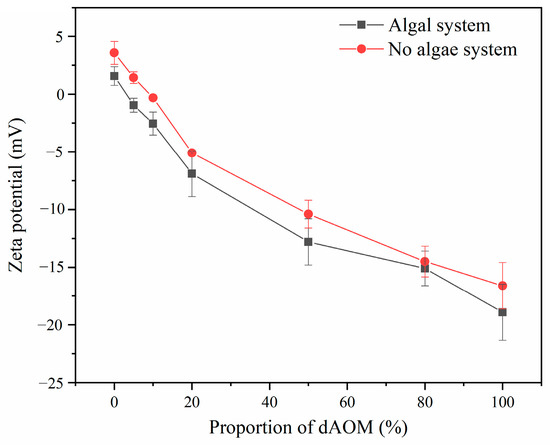
Figure 1.
Zeta potential of MC in the algal and non-algal systems at different dAOM concentrations.
The zeta potential value of MC in the algal system was lower at the same quantity of dAOM due to the negative charge on the surface of the algal cells, ranging from 1.56 mV to −18.9 mV. However, the zeta potential is not the main predictor of flocculation effectiveness. The impact of flocculation is influenced by the AOM concentration and component distribution in addition to the zeta potential.
3.1.2. Flocs
The stable floc particle size is the average value of Dv50 after flocculation equilibrium in the growth stage, which can also reflect the flocculation effect to a certain extent. The strength of flocs refers to the ability of the flocs to resist the shear force. If the applied shear force is greater than the intergranular force, the flocs break, and the lower the strength of the flocs, the more easily they break into small granular flocs, which reduces the flocculation settling performance. The higher the strength factor of the flocs, the better the flocculation effect is [22]. The broken flocs can reaggregate, which is the regeneration process of the flocs. The regeneration capacity of the flocs can determine the subsequent flocculation effect to some extent. The stronger the regeneration capacity, the higher the subsequent flocculation efficiency [23].
The dAOM produced by microalgal cells influences the size, strength, and regeneration of flocs formed by the MC during the flocculation process. At low dAOM concentrations, MC flocs have bigger particle sizes. However, as the dAOM concentration increases, the flocs progressively shrink; the same change pattern is shown in floc strength and regeneration (Figure 2). dAOM can increase the flocculation efficiency by establishing interparticle bridging or adhesion on the particle surface [24]. Similar studies have found that AOM operates as an auxiliary flocculant only at low doses and that it acts similarly to synthetic polymeric auxiliary flocculants, creating larger flocs [25].
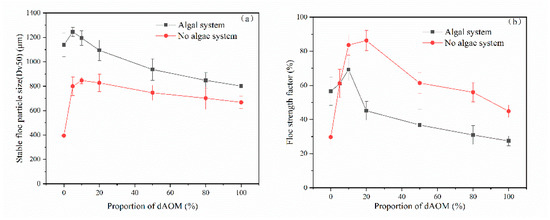
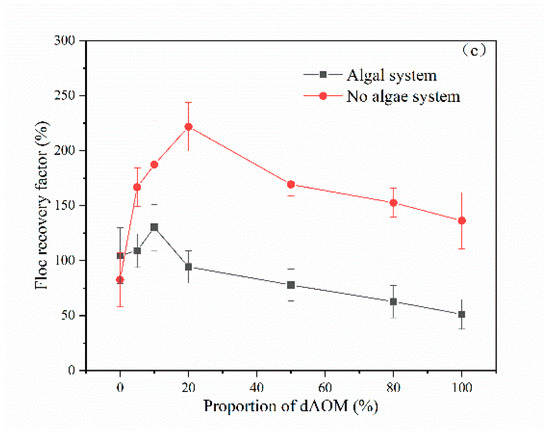
Figure 2.
Stable floc size (a), strength factor (b), and recovery factor (c) of MC in algal and non-algal systems at different dAOM concentrations.
Furthermore, Gregory discovered that certain natural organic materials may be adsorbed on the surface of particles and colloids, extending in a ring- or tail-like shape and making these colloids and particles more stable [26], resulting in enhanced floc strength at low concentrations (Figure 2b). When the concentration of dAOM is low, the regeneration of the flocs created by MC is strong, approximately 100%; that is, the size of regenerated floc particles is greater than that of newly formed flocs (Figure 2c). This is because MC mainly relies on electric neutralization and bridging in the flocculation process, resulting in larger particle size of the flocs formed. Moreover, the growth of flocs during electric neutralization flocculation is mainly a physical process, which has nothing to do with the destruction of chemical bonds. Therefore, the broken flocs can recover and have strong regeneration [27,28].
The results in Figure 1 further show that when the dAOM content is less than 10%, the zeta potential is approximately 0 mV, and particle repulsion is mild, which helps the MC flocculation process. The changes in zeta potential with dAOM concentration in Figure 1 indicate that when the dAOM concentration is high, the negative charge on the particle surface increases, the zeta potential in the system changes from positive to negative, and the repulsion between the particles is enhanced, inhibiting particle flocculation. The particle size and strength of the stable flocs produced by MC are smaller (Figure 2a,b). As for floc regeneration, on the one hand, when dAOM concentration increases, the potential becomes more and more negative, and particle repulsion gets stronger and stronger, which is not favorable for floc regeneration. On the other hand, dAOM combines with sites on the dispersed particles following breakage, resulting in reaggregated particles. The presence of a substantial quantity of dAOM lowers the number of active binding sites [25], resulting in a steady reduction in regenerability (Figure 2c).
AOM on the surface of cyanobacterial cells contains a large number of gel substances, such as viscous polysaccharides, which can bind cells or particles into an aggregated state [29]. Additionally, due to the presence of algal cells, the stable flocs generated by MC in the algal system have a larger particle size than those in the non-algal system. Chekli et al. discovered that the strength of alga-containing flocs was significantly lower than that of NOM flocs [30]. Galloux et al. discovered that the significantly larger size of algal cells than organic molecules may affect the association of hydrolysates and organics during flocculation [31]. Zhao found that combining algal cells with flocs reduces floc-binding capability, and the presence of algae promotes the formation of loose flocs that are readily broken and difficult to regenerate [32]. As a result, the floc strength in the non-algal system was much higher than in the algal system (Figure 2).
3.1.3. Flocculation Kinetics
The growth rate of MC flocs formed in the presence of dAOM exhibited a similar propensity to expand and then decrease as dAOM concentration increased (Figure 3). The change trend was similar to those in floc particle size, strength, and regeneration. dAOM at low concentration promotes the MC flocculation process, accelerates floc formation, increases the speed at which MC creates stable flocs, and improves the flocculation effect; a high dAOM content inhibits the flocculation process, and the floc formation rate is slow, weakening the flocculation effect. Furthermore, because the presence of algal cells accelerates the binding of the cells or particles into aggregates [29], flocs grew quicker in the algal system than in the non-algal system.
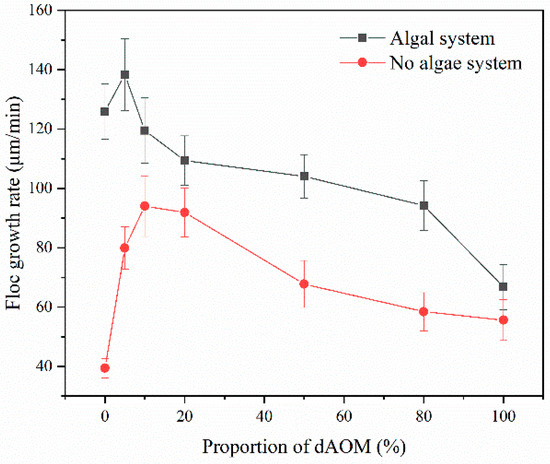
Figure 3.
Growth rate of flocs in algal and non-algal systems at different dAOM concentrations.
3.2. Effect of dAOM on the Algal Removal Efficiency of MC
dAOM in the algal system had a substantial influence on the algal removal efficiency of MC, and as the dAOM concentration increased, the removal effectiveness of MC on algal cells steadily declined (Figure 4a). When the dispersion medium lacked dAOM or most of the dAOM was eliminated, the algal removal effectiveness of MC after three hours of flocculation reached approximately 80%, and the algal removal effect was better. In contrast, when the concentration of dAOM was high, it inhibited the algal removal effect of MC. To obtain the same algal removal efficacy in each experimental group, the dose of MC had to increase as the concentration of dAOM rose (Figure 4b). When the dAOM concentration was low, dAOM had little effect on the algal removal effect of MC; when the dAOM concentration was high, dAOM may have interacted with MC, attenuating the algal removal effect of MC, reducing the effective concentration of MC for algae removal, and raising the dose of MC.
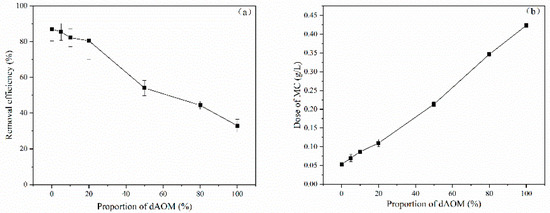
Figure 4.
Removal efficiency of MC after three hours under different concentrations of dAOM (a), dosage of MC under different concentrations of dAOM at the same algal removal efficiency (80 ± 3%) (b).
3.3. Mechanism of dAOM Affecting Flocculation and Algal Removal Efficiency of MC
3.3.1. Changes in dAOM Properties
The changes in dAOM before and after adding MC, including changes in the dAOM concentration, hydrophilicity, and molecular weight, were examined to explore the mechanism of dAOM impacting the flocculation process and algae removal effectiveness of MC.
AOM is a complex mixture of organic molecules, and its concentration is often expressed in terms of dissolved organic carbon (DOC). To replicate varying dAOM levels, the DOC concentration in each experimental group gradually increased from 0.25 mg/L to 7 mg/L (Figure 5a). After three hours of MC treatment, the DOC content dropped, and while the relative decline rate was higher in the low-concentration group, the absolute quantity of DOC elimination was higher in the high-concentration group. The results revealed that dAOM was involved in the flocculation and algal removal processes of MC, MC mixed with some dAOM, and the quantity of dAOM involved in the flocculation process rose as the dAOM concentration in the system increased.
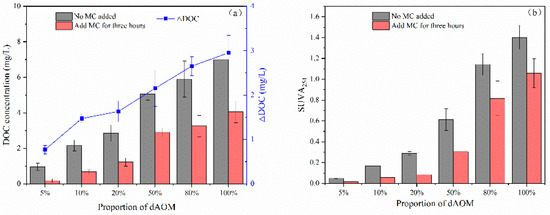
Figure 5.
Changes in DOC content before and three hours after adding MC (a), change in SUVA254 in the system before and three hours after adding MC (b).
SUVA254 can be used to determine the aromaticity of chemical compounds. The greater the number, the more aromatic structures and conjugated double bonds there are in the solution, resulting in a lower hydrophilicity and a higher hydrophobicity. The SUVA254 value of Prorocentrum donghaiense was 1.40 m−1·mg−1 and the SUVA254 value of dAOM in the exponential development phase was approximately 1–2 m−1·mg−1 L [33]. The SUVA254 value grew significantly with increasing dAOM concentration (Figure 5b), as did the amount of aromatic compounds in the system and the hydrophobicity. Pivokonska and colleagues observed that flocculation preferentially removes hydrophobic NOM components over hydrophilic NOM components [34]. SUVA254 greatly decreased after the addition of MC. The results suggest that MC will preferentially bind hydrophobic substances rather than hydrophilic substances throughout the flocculation and algal removal processes, therefore weakening the system’s hydrophobicity and increasing its hydrophilicity.
With a variation range of 25,280–89,800 g/mol, the molecular weight rose as the dAOM concentration increased (Figure 6a). After three hours of MC flocculation, the system’s molecular weight fell considerably. For example, when the dAOM concentration was 100%, i.e., when the original algal liquid was utilized, the system’s molecular weight dropped from 89,800 g/mol to 48,820 g/mol. MC may significantly reduce the system’s molecular weight during the flocculation and algal removal procedures.
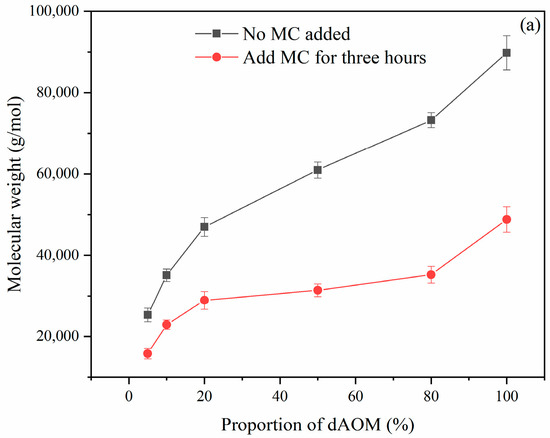
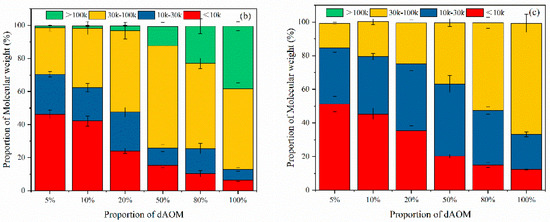
Figure 6.
Change in molecular weight before and three hours after adding MC (a), change in molecular weight distribution before adding MC (b), change in molecular weight distribution three hours after adding MC (c).
According to the relative molecular weight distribution at different dAOM concentrations, after three hours of MC flocculation, the proportion of high-molecular-weight components was considerably reduced, whilst the proportion of low-molecular-weight components was greatly increased. In the group with 100% dAOM, the components with a molecular weight of >100k g/mol were completely removed by MC, whereas the low-molecular-weight components (10k g/mol and 10k–30k g/mol) increased from 12.9% to 33.16%. (Figure 6c). It is possible to conclude that MC preferentially binds high-molecular-weight components. The high-molecular-weight portion of dAOM is dominated by polysaccharides and protein components. These compounds have very high surface activity due to a large number of metal-binding functional groups, such as carboxyl and hydroxyl groups, which help to selectively remove high-molecular-weight dAOM by aluminum coagulation [35].
3.3.2. Mechanism of Analysis
The shape and characteristic features of particles are efficient indicators of the flocculation process. The correlation analysis of floc features with dAOM concentration showed a substantial inverse relationship between DOC and the floc size, growth rate, strength, and regeneration (Table 1). Flocculation is the primary mechanism of MC removal of bloomed algae. The relationship between floc features and algal removal efficiency in the presence of dAOM was investigated. The algal removal efficiency was discovered to be strongly positively linked with floc regeneration, floc particle size, floc strength, and floc growth rate (Table 2). Therefore, the larger the size of the flocs generated by MC, the higher the strength of the flocs, the stronger the regeneration of the flocs and the faster the growth rate of the flocs, the better the effect of removing algae.

Table 1.
Correlation analysis between DOC and floc size, floc strength factor, floc recovery factor, and floc growth rate.

Table 2.
Correlation analysis between algal removal efficiency and floc size, floc strength, floc recovery factor, and floc growth rate.
The above analyses indicated that dAOM affects the removal of algae by affecting the flocculation process of MC. When a small quantity of dAOM participates in the flocculation process of MC, MC preferentially combines with hydrophobic macromolecular organic matter, while a small amount of hydrophobic macromolecular organic matter promotes flocculation in a manner similar to that of synthetic polymer auxiliary flocculants, which helps accelerate the flocculation process, and the generated flocs to expand quicker. Therefore, the removal efficiency of MC is higher when dAOM concentration is low. When the concentration of dAOM in water is high, the repulsive force between particles is enhanced due to the increase in the negative charge on the surface of particles, which inhibits the flocculation process of MC. Therefore, the efficiency of algal removal of MC is low.
Thus, this work demonstrated AOM as a significant factor impacting the flocculation and algal removal efficacy of MC, and it paved the path for the future development of MC materials and associated algal bloom control technologies. When using MC to control algal bloom, special consideration should be given to AOM in water, specifically to investigate the best method and opportunity for applying MC, as well as to optimize MC application technology for the concentration and composition of AOM, which have a significant impact on the flocculation process. In order to solve the aforementioned challenges, further research and development of MC resistant to the influence of organic matter is also a development route. Existing studies have made excellent progress, such as the incorporation of hydrophobic-enhanced organic macromolecular compounds in clay modification, by modifying acrylamide copolymer and chitosan to improve the flocculation effects of MC in high-organic-matter water, in order to achieve a high-efficiency algal removal effect [36,37].
4. Conclusions
In this work, we investigated the influence of dAOM on MC flocculation and algal removal efficiency, and the results initially revealed the mechanism of MC flocculation in environments with different dAOM characteristics. When the concentration of dAOM is low, MC preferentially binds to the hydrophobic macromolecular components in dAOM, which act as coagulants by bridging or adhering particles. As a result, MC flocculation is faster, the floc particle size is greater, the floc strength is stronger, and the floc regeneration is better, which increases the flocculation and algal removal efficiency of MC. When dAOM concentrations are high, a substantial quantity of dAOM becomes entangled with MC, diminishes the system’s zeta potential, enhances particle repulsion, hinders the flocculation process, and significantly reduces the MC algal removal efficiency. According to the findings of this study, the amount of MC must be increased in order to effectively control HABs.
Considering the inhibitory effect of dAOM on algal removal efficiency of MC, it is recommended to use MC in the early stages of HABs, as studies have shown that the concentration of dAOM increases with the survival time of algal cells, which increases the amount of MC used [19]. Using a tiny dose of MC at this time can create a greater algal removal impact. As can be seen, early detection of HABs is critical, and future prevention and control of HABs requires thorough management in many domains. Moreover, MC designed for usage in high-organic-matter water bodies can be produced to withstand the influence of high-organic-matter water bodies on MC algal removal. This research gives theoretical support for future HAB control and MC use in the field.
Supplementary Materials
The following supporting information can be downloaded at: https://www.mdpi.com/article/10.3390/jmse11030613/s1, Table S1: Composition and content of artificial seawater; Table S2: Experimental grouping of different concentrations of dAOM in algal system; Table S3: Experimental grouping of different concentrations of dAOM in non algae system; Table S4: Parameters of the fluorometer.
Author Contributions
M.W.: Literature retrieval, data analysis, manuscript writing; B.Z.: Data collection, data analysis; X.C.: Research and design guidance, manuscript review, financial support; X.S.: research and design guidance, manuscript review, financial support; Z.Y.: Research and design guidance, manuscript review, financial support; F.L.: Reviewing manuscripts. All authors have read and agreed to the published version of the manuscript.
Funding
This research was supported by the National Natural Science Foundation of China (Grant No. 41976145), the China National Key R&D Program during the 14th Five-year Plan Period (Grant No. 2022YFC3105304), the Key Research Program of the Center for Ocean Mega-Science Chinese Academy of Sciences (Grant No. COMS2020J02), and the National Key Research and Development Program (Inter-Governmental Key Project for International Cooperation in Science and Technology Innovation) (Project No. SQ2022YFE010525).
Institutional Review Board Statement
Not applicable.
Informed Consent Statement
Not applicable.
Data Availability Statement
The data presented in this study are available on request from the corresponding author.
Acknowledgments
The authors would like to acknowledge Wenbin Jiang and Xiaomiao Zang for their advice on writing this article.
Conflicts of Interest
The authors declare no conflict of interest.
References
- Yu, Z.; Chen, N. Emerging trends in red tide and major research progresses. Oceanol. Limnol. Sin. 2019, 50, 474–486. [Google Scholar]
- Anderson, D.M.; Cembella, A.D.; Hallegraeff, G.M. Progress in Understanding Harmful Algal Blooms: Paradigm Shifts and New Technologies for Research, Monitoring, and Management. Annu. Rev. Mar. Sci. 2012, 4, 143–176. [Google Scholar] [CrossRef] [PubMed]
- Grattan, L.M.; Trainer, V.L. Special Issue: Harmful Algal Blooms and Public Health Preface. Harmful Algal 2016, 57, 1. [Google Scholar] [CrossRef] [PubMed]
- Anderson, D.M. Turning back the harmful red tide—Commentary. Nature 1997, 388, 513–514. [Google Scholar] [CrossRef]
- Anderson, D.M. Approaches to monitoring, control and management of harmful algal blooms (HABs). Ocean Coast. Manag. 2009, 52, 342–347. [Google Scholar] [CrossRef]
- Yu, Z.; Zou, J.; Ma, X. A new method to improve the capability of clays for removing red tide organisms. Oceanol. Limnol. Sin. 1994, 25, 226–232. [Google Scholar]
- Liu, Y.; Cao, X.H.; Yu, Z.M.; Song, X.X.; Qiu, L.X. Controlling harmful algae blooms using aluminum-modified clay. Mar. Pollut. Bull. 2016, 103, 211–219. [Google Scholar] [CrossRef]
- Yu, Z.M.; Song, X.X.; Cao, X.H.; Liu, Y. Mitigation of harmful algal blooms using modified clays: Theory, mechanisms, and applications. Harmful Algae 2017, 69, 48–64. [Google Scholar] [CrossRef]
- Brezinski, K.; Gorczyca, B. An overview of the uses of high performance size exclusion chromatography (HPSEC) in the characterization of natural organic matter (NOM) in potable water, and ion-exchange applications. Chemosphere 2019, 217, 122–139. [Google Scholar] [CrossRef]
- Golea, D.M.; Jarvis, P.; Jefferson, B.; Moore, G.; Sutherland, S.; Parsons, S.A.; Judd, S.J. Influence of granular activated carbon media properties on natural organic matter and disinfection by-product precursor removal from drinking water. Water Res. 2020, 174, 11. [Google Scholar] [CrossRef]
- Alldredge, A.L.; Silver, M.W. Characteristics, dynamics and significance of marine snow. Prog. Oceanogr. 1988, 20, 41–82. [Google Scholar] [CrossRef]
- Jiang, W.B.; Yu, Z.M.; Cao, X.H.; Jiang, K.Q.; Yuan, Y.Q.; Anderson, D.M.; Song, X.X. Effects of soluble organics on the settling rate of modified clay and development of improved clay formulations for harmful algal bloom control. Environ. Pollut. 2021, 289, 11. [Google Scholar] [CrossRef] [PubMed]
- Ji, H.N.; Yu, Z.M.; He, L.Y.; Zhu, J.N.; Cao, X.H.; Song, X.X. Programmed cell death induced by modified clay in controlling Prorocentrum donghaiense bloom. J. Environ. Sci. 2021, 109, 123–134. [Google Scholar] [CrossRef]
- Wang, X.X.; Liu, B.M.; Lu, M.F.; Li, Y.P.; Jiang, Y.Y.; Zhao, M.X.; Huang, Z.X.; Pan, Y.; Miao, H.F.; Ruan, W.Q. Characterization of algal organic matter as precursors for carbonaceous and nitrogenous disinfection byproducts formation: Comparison with natural organic matter. J. Environ. Manag. 2021, 282, 9. [Google Scholar] [CrossRef] [PubMed]
- Pivokonsky, M.; Naceradska, J.; Kopecka, I.; Baresova, M.; Jefferson, B.; Li, X.; Henderson, R.K. The impact of algogenic organic matter on water treatment plant operation and water quality: A review. Crit. Rev. Environ. Sci. Technol. 2016, 46, 291–335. [Google Scholar] [CrossRef]
- Pivokonsky, M.; Safarikova, J.; Bubakova, P.; Pivokonska, L. Coagulation of peptides and proteins produced by Microcystis aeruginosa: Interaction mechanisms and the effect of Fe-peptide/protein complexes formation. Water Res. 2012, 46, 5583–5590. [Google Scholar] [CrossRef]
- Bernhardt, H.; Hoyer, O.; Schell, H.; Lüsse, B. Reaction mechanisms involved in the influence of algogenic organic matter on flocculation. Z. Wasser. Abwasser. Forsch 1985, 18, 18–30. [Google Scholar] [CrossRef]
- Bernhardt, H.; Hoyer, O.; Lusse, B.; Schell, H. Influence of Algogenic Organic-Substances on Flocculation and Filtration. Acta Hydrochim. Hydrobiol. 1989, 17, 235–277. [Google Scholar] [CrossRef]
- Pivokonsky, M.; Safarikova, J.; Baresova, M.; Pivokonska, L.; Kopecka, I. A comparison of the character of algal extracellular versus cellular organic matter produced by cyanobacterium, diatom and green alga. Water Res. 2014, 51, 37–46. [Google Scholar] [CrossRef]
- Jarvis, P.; Jefferson, B.; Parsons, S.A. Breakage, regrowth, and fractal mature of natural organic matter flocs. Environ. Sci. Technol. 2005, 39, 2307–2314. [Google Scholar] [CrossRef]
- Weishaar, J.L.; Aiken, G.R.; Bergamaschi, B.A.; Fram, M.S.; Fujii, R.; Mopper, K. Evaluation of specific ultraviolet absorbance as an indicator of the chemical composition and reactivity of dissolved organic carbon. Environ. Sci. Technol. 2003, 37, 4702–4708. [Google Scholar] [CrossRef] [PubMed]
- Shi, W.Q.; Tan, W.Q.; Wang, L.J.; Pan, G. Removal of Microcystis aeruginosa using cationic starch modified soils. Water Res. 2016, 97, 19–25. [Google Scholar] [CrossRef] [PubMed]
- Yukselen, M.A.; Gregory, J. The reversibility of floc breakage. Int. J. Miner. Process. 2004, 73, 251–259. [Google Scholar] [CrossRef]
- Pivokonsky, M.; Kloucek, O.; Pivokonska, L. Evaluation of the production, composition and aluminum and iron complexation of algogenic organic matter. Water Res. 2006, 40, 3045–3052. [Google Scholar] [CrossRef]
- Henderson, R.K.; Parsons, S.A.; Jefferson, B. The impact of differing cell and algogenic organic matter (AOM) characteristics on the coagulation and flotation of algae. Water Res. 2010, 44, 3617–3624. [Google Scholar] [CrossRef]
- Gregory, J. The role of colloid interactions in solid-liquid separation. Water Sci. Technol. 1993, 27, 1–17. [Google Scholar] [CrossRef]
- Bo, X.W.; Gao, B.Y.; Peng, N.N.; Wang, Y.; Yue, Q.Y.; Zhao, Y.C. Coagulation performance and floc properties of compound bioflocculant-aluminum sulfate dual-coagulant in treating kaolin-humic acid solution. Chem. Eng. J. 2011, 173, 400–406. [Google Scholar] [CrossRef]
- Chekli, L.; Eripret, C.; Park, S.H.; Tabatabai, S.A.A.; Vronska, O.; Tamburic, B.; Kim, J.H.; Shon, H.K. Coagulation performance and floc characteristics of polytitanium tetrachloride (PTC) compared with titanium tetrachloride (TiCl4) and ferric chloride (FeCl3) in algal turbid water. Sep. Purif. Technol. 2017, 175, 99–106. [Google Scholar] [CrossRef]
- Sun, F.; Wang, F.Y.; Jiang, H.L.; Huang, Q.Y.; Xu, C.H.; Yu, P.; Cong, H.B. Analysis on the flocculation characteristics of algal organic matters. J. Environ. Manag. 2022, 302, 8. [Google Scholar] [CrossRef]
- Chekli, L.; Phuntsho, S.; Roy, M.; Shon, H.K. Characterisation of Fe-oxide nanoparticles coated with humic acid and Suwannee River natural organic matter. Sci. Total Environ. 2013, 461, 19–27. [Google Scholar] [CrossRef]
- Galloux, J.; Chekli, L.; Phuntsho, S.; Tijing, L.D.; Jeong, S.; Zhao, Y.X.; Gao, B.Y.; Park, S.H.; Shon, H.K. Coagulation performance and floc characteristics of polytitanium tetrachloride and titanium tetrachloride compared with ferric chloride for coal mining wastewater treatment. Sep. Purif. Technol. 2015, 152, 94–100. [Google Scholar] [CrossRef]
- Zhao, Y.X.; Lian, H.Q.; Tian, C.; Li, H.B.; Xu, W.Y.; Phuntsho, S.; Shih, K.M. Surface water treatment benefits from the presence of algae: Influence of algae on the coagulation behavior of polytitanium chloride. Front. Environ. Sci. Eng. 2021, 15, 13. [Google Scholar] [CrossRef]
- Pivokonska, L.; Pivokonsky, M.; Tomaskova, H. Optimization of NOM removal during water treatment. Sep. Sci. Technol. 2008, 43, 1687–1700. [Google Scholar] [CrossRef]
- Pivokonsky, M.; Pivokonska, L.; Baumeltova, J.; Bubakova, P. The effect of cellular organic matter produced by cyanobacteria Microcystis aeruginosa on water purification. J. Hydrol. Hydromech. 2009, 57, 121–129. [Google Scholar] [CrossRef]
- Henderson, R.K.; Baker, A.; Parsons, S.A.; Jefferson, B. Characterisation of algogenic organic matter extracted from cyanobacteria, green algae and diatoms. Water Res. 2008, 42, 3435–3445. [Google Scholar] [CrossRef] [PubMed]
- Yu, Q.; Yu, Z.M.; Song, X.X.; Cao, X.H.; Jiang, W.B.; Chu, Y.Y. The synthesis of an acrylamide copolymer and its synergistic effects on clay flocculation of red tide organisms. J. Environ. Manag. 2023, 332, 117326. [Google Scholar] [CrossRef]
- Li, H.; Yu, Z.M.; Cao, X.H.; Song, X.X. Chitosan modification and its synergism with clay to mitigate harmful algal blooms. Environ. Technol. Innov. 2023, 29, 13. [Google Scholar] [CrossRef]
Disclaimer/Publisher’s Note: The statements, opinions and data contained in all publications are solely those of the individual author(s) and contributor(s) and not of MDPI and/or the editor(s). MDPI and/or the editor(s) disclaim responsibility for any injury to people or property resulting from any ideas, methods, instructions or products referred to in the content. |
© 2023 by the authors. Licensee MDPI, Basel, Switzerland. This article is an open access article distributed under the terms and conditions of the Creative Commons Attribution (CC BY) license (https://creativecommons.org/licenses/by/4.0/).